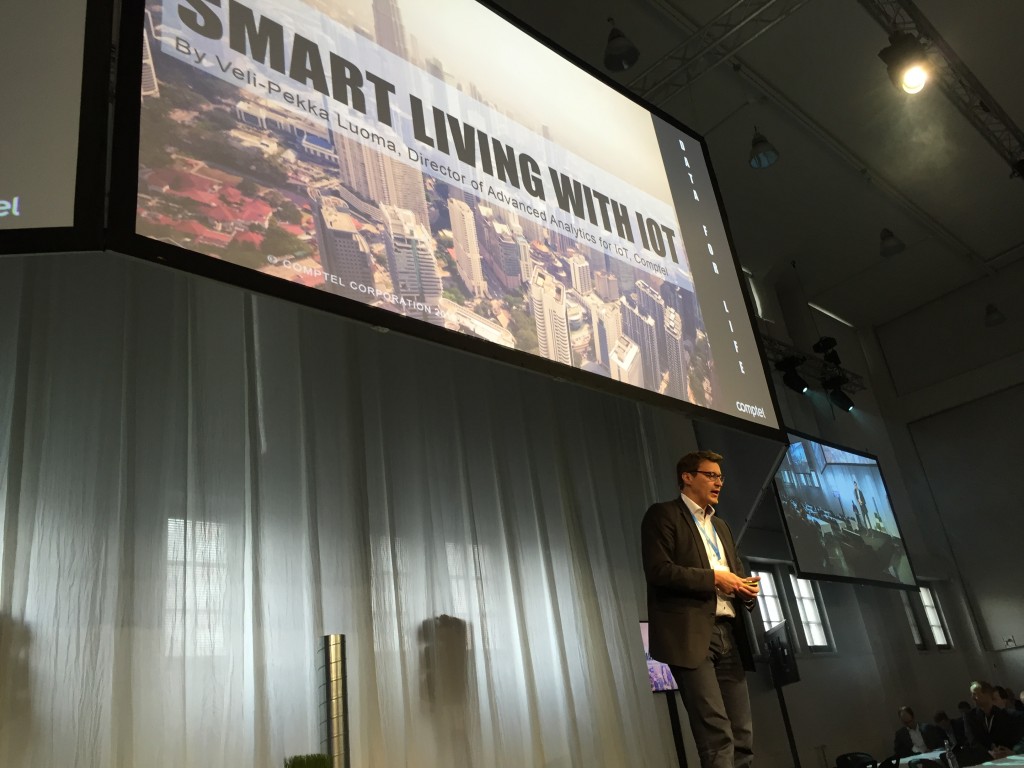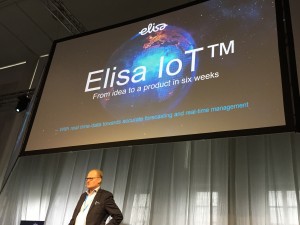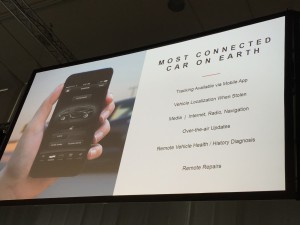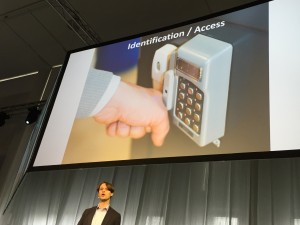Posted: May 20th, 2016 | Author: Special Contributor | Filed under: Events | Tags: NFV, NFV World Congress, Virtualisation | Comments Off on NFV World Congress 2016 Underscores Progress in NFV Implementations
By Stephen Lacey, Principal NFV Architect, CTO Office & Guest Author
Comptel was in attendance for the second annual NFV World Congress, held last month in Silicon Valley. Whereas the discussions at last year’s inaugural event were more academic in nature, this year’s conference showcased a number of compelling cases that demonstrate how network functions virtualisation (NFV) is taking a step toward becoming reality.
The week kicked off with a series of tutorials from the Open Networking Foundation (ONF), the European Telecommunication Standard Institute’s (ETSI) Industry Specification Group (ISG) for NFV, and the Intel Network Builders (INB) – Comptel is a proud member of the latter two groups. Throughout the week, we also observed a number of presentations from operators driving home the reasons why they are exploring NFV implementations. Two reasons stood out:
- The potential reductions in CAPEX/OPEX due to utilising ubiquitous general purpose hardware
- The ability to achieve service flexibility and mix and match services.
NFV in Action
Japanese operator NTT offered a great example of the benefits of service flexibility. During a tsunami in 2014, the need for voice traffic capacity near the storm’s epicentre increased dramatically. There was plenty of capacity in the other parts of their network, so if NFV had been available at that time, NTT would have been able to offload data capacity to other parts of the network to increase voice capacity in areas that would have needed it most.
NTT was the only operator at NFV World Congress running two different virtualised evolved package core (vEPC) vendors on live deployments: NEC and Fujitsu.
AT&T, Verizon and the bulk of the operators speaking at the event said that virtual customer premises equipment (vCPE) for enterprise-based services is the most compelling of the NFV use cases for them. When pressed, AT&T described how their customers had surprised them in the way they utilise services.
By using the AT&T ECOMP platform and EVPN as the bridging mechanisms for Layer 2 and Layer 3 switching, plus allowing their customers to chain virtual network functions together, customers enjoyed time-of-day-based services variation. For example, during the workday all branch offices had equal bandwidth to access the main datacentres, whereas after business hours those bandwidth allocations were lowered and higher bandwidth was assigned for datacentres to sync together.
Other operators said they are entrenched in NFV trials, but didn’t offer any behind-the-scenes information as to how those programs are progressing.
The Emergence of Open Source
Another important theme was the increasing mainstream relevance of open source projects, which major network equipment providers (NEPs) and communication services providers (CSPs) are relying on to prevent vendor lock-in within the network.
It seems 2016 is the year of orchestration wars, with two different open source projects exploring this aspect of network management and organization (MANO): Open Source MANO (OSM) and OPEN-Orchestrator (OPEN-O). It’s difficult to directly compare the two initiatives, since OSM is based on available software, whereas OPEN-O is only in its foundational stages.
Nonetheless, it will be interesting to keep an eye on each initiative as they progress. Comptel recently participated in a partner showcase at TM Forum Live! alongside Telefonica, Indra and Etiya which proposed a hybrid network environment based on OSM.
NFV World Congress offered a compelling venue to explore how leading operators and vendors are actively experimenting with NFV implementation. As a few pioneering telcos embrace virtualisation within the network, these first forays will carve a clear path forward for the rest of the industry. Some will take the lead; others will simply follow.
Comptel’s proposed Digital Service Lifecycle Management (DSLM) model is just one example of how we are creating new possibilities for service orchestration through NFV implementation. Download a new whitepaper from Heavy Reading to learn more about this concept, and dive into the conversation on Nexterday.org, our online magazine and reader community.
Posted: May 17th, 2016 | Author: Malla Poikela | Filed under: Events | Tags: Intelligent Fast Data, IoT, IoTNordic | Comments Off on #IoTNordic 2016 Recap: Spotlight on IoT Partnerships and Potential
Last month, a sold-out crowd of 500 IoT enthusiasts packed into Helsinki’s Kattilahalli conference hall for the Internet of Things 2016 Conference, also known as #IoTNordic. With a DJ playing live music throughout the two-day show, a saxophonist entertaining the crowd in the late afternoon happy hour and outdoor food vans offering tasty meals, the event offered a hip, modern and invigorating atmosphere for lively discussions on the potential and partnerships that define the IoT.

Veli-Pekka Luoma, Comptel
Although environmentalism was a major theme (event organisers used recycled wooden pallets as booth tables, for example), the event and the attendees were focused on different kind of environment: the holistic IoT ecosystem. There was one common denominator: Nearly everyone in attendance, across industries, was looking for technology partners to help them build or expand their own ecosystem of connected device solutions.
Comptel sponsored #IoTNordic and presented a speaking session with our Director of Advanced Analytics for IoT, Veli-Pekka Luoma, about the vital role data plays in the Smart Living movement. Comptel’s Intelligent Fast Data solutions offer businesses the power to sense, understand and act instantly on data “across the board.” Connected devices are another data source that produces aggregated information, alongside customer interactions, the network, social media, location and more. Businesses stand to benefit tremendously by pulling insights from all those different sources and applying insights to real-time actions. Those actions lead to better IoT-enabled experiences.
Industry can remotely monitor heavy machinery to run a “smart factory.” Health care providers can track personal data to offer intelligent preventative care, fleet managers can optimise routes for cargo vehicles, utility providers can provide efficient energy solutions with smart meters, and much more.
It all starts with smarter data. Through experimentation, partnership and solution co-creation, businesses – including operators – can apply data analytics to elevate the IoT beyond simple machine-to-machine communications toward humanistic benefits. #IoTNordic offered several compelling examples of businesses that are already succeeding in the IoT.
Elisa’s IoT Innovation Challenge

Elisa VP Markku Hollström
The Finnish operator Elisa has enjoyed many successes along its digital transformation. Its IoT service offering is one example. The company offers IoT connectivity, monitoring and analytics to a range of verticals, including a 3D real-time “Smart Factory” dashboard for industry, augmented reality solutions, and analytics-enriched monitoring and email notifications for the marine manufacturer Wärtsilä.
Elisa VP Markku Hollström explained that to succeed in the IoT, you need to experiment and develop a broad network of partners. That enables speed – the company profiled IoT projects that went from ideation to product in just six weeks. It’s also why the company is inviting businesses to participate in the Elisa Innovation Challenge, which will reward up to €85,000 in prizes to entrants who create innovative corporate and Smart Home IoT solutions.
Technology, Customer Experience the Focus for Tesla

Tesla presentation at IoT Nordic
The electric car manufacturer Tesla says it is not in the business of selling luxury vehicles. At the show, the company’s speaker said the company’s focus is actually in transitioning the world toward safer, sustainable transportation. The IoT plays a big role in that: Tesla says its vehicles are the most connected cars on Earth, and their mission is to incorporate technology to create a software-based, analytics-informed driving experience. Even their car buying experience is innovative; it’s entirely online, making it a modern, customer-focused approach to purchasing.
Are Device Implants the Future of Health?

Hannes Sjöblad, BioNyfiken
Hannes Sjöblad of BioNyfiken presented a fascinating look at the role of NFC implants in human health, which his company says is humanity’s “personal key to the IoT”. This technology already exists – in fact, we saw a live demo at the end of his presentation of a human implant placed into a person’s hand. While also a bit scary, the demo did show the amazing potential of implanted devices to enable everyday individuals to “speak” to connected devices.
There are simple but very relevant use cases, like replacing keys, ID cards, tickets and boarding passes with implanted chips, and use cases that are more humanistic. Personalised chips could ensure a gun can’t be operated by an unauthorised user, for example, or even play a role in curing blindness, deafness and paralysis.
Securing the IoT
Of course, any conversation about the many uses cases for the IoT eventually falls back on security concerns. In his keynote speech, Mikko Hyppönen, Chief Research Officer of F-Secure explained that the IoT will only expand the number of threat vectors (how do you secure your Wi-Fi if it’s being shared by your refrigerator?), creating more opportunity for highly sophisticated cyber criminals and making it more difficult for consumers to maintain privacy.
The number and variety of IoT devices will make single-device protection impractical, said Hyppönen. F-Secure, for example, has no interest in developing anti-virus protection for your connected toaster. However, the company does develop full-home Wi-Fi security solutions to ensure every device on the network is secure. Furthermore, F-Secure compensates independent hackers who find holes in their security system, when many of those hackers may have otherwise sold that information to cyber criminals. It’s a good solution for F-Secure: Paying for hackers to find holes in your system is a clever and efficient way to find vulnerable spots in your environment.
As Hyppönen said, ”Web content is not free. It is paid for with your data. It’s paid for with your privacy. And it’s too late to change that. We have raised a whole new generation who are used to having content for ‘free’ on the web. And yet, we don’t understand what this means.”
That’s an important takeaway to keep in mind as businesses and operators tiptoe – or dive head-first – into the futuristic world of the IoT.
Learn more about the IoT opportunity for telco in a new whitepaper from Comptel and Heavy Reading. Download “Smart Cities & Smart Living: The Role of Telecom Operators.”
Posted: May 16th, 2016 | Author: Steve Hateley | Filed under: Compelling Cases | Tags: digital service lifecycle management, NFV, OSS/BSS, service orchestration | Comments Off on How Digital Service Lifecycle Management Delivers Speed, Configurability and Accuracy
Comptel participated in several partner showcases during last week’s TM Forum Live! 2016 in Nice, France, with one in particular reimagining the model of digital service delivery for the modern B2B and B2C customer.
As Comptel CTO Simon Osborne explained, Comptel partnered with IBM and Juniper Networks in an IBM Cloud-Based Networking architecture. The project introduces new strategies for leveraging software-defined networks (SDN) and network functions virtualisation. As a result, operators can efficiently automate and reconfigure parts of their network to enable automated, self-service digital service delivery. As part of the partnership, we’re contributing our Digital Service Lifecycle Management (DSLM) model, technology and expertise.

Digital Service Lifecycle Management (DSLM) architecture
In an earlier blog, I explained why this needs to happen. B2B and B2C customers today want personalisation, convenience and instant gratification in the purchasing process. Operators need to evolve their infrastructure to deliver better customer experiences to stay competitive, and network virtualisation gives operators the agility and flexibility they need to do so.
The key to introducing new capabilities gradually – since complete network overhauls aren’t practical for most operators – is to introduce “islands” of NFV capabilities into the network. On top of that, fresh approaches to managing the interconnection between physical and virtual resources will ensure operators can achieve this agility quickly, and at minimal cost.
In this post, I’ll explain just how you do that.
What is Digital Service Lifecycle Management
Comptel first introduced DSLM in our white paper – Digital Service Lifecycle Management: How CSPs Can Play a Successful Role in the Digital Economy. As Heavy Reading analyst Caroline Chappell wrote, operators today face competition from cloud-born companies like Google and Amazon, which have the infrastructure flexibility to spin up attractive new digital services much faster than the average operator.
Portraying the future role of operators as aggregators of digital services (from which the average consumer and business could buy whatever services they need to fill out their “personal digital ecosystems”), Chappell said network evolution is required to enable “on-demand personalised service creation.”

Digital Service Lifecycle Management (DSLM) layers
DSLM is how you evolve the network. It’s the middle portion of a three-tiered system that decides how virtual and physical network resources are managed to support service requests from front office systems.
How the Three-Tiered DSLM Model Works
This NFV-driven model requires three layers: one for resource management, one for digital service lifecycle management and one for business management.
The customer only ever sees the business management layer, which sits at the top and comprises the shopping environment, order configuration and payment tools. Customers configure and purchase services available through a digital catalogue, and automated ordering and billing capabilities ensure customer requests are quickly passed on for configuration and fulfillment.
The middle digital service lifecycle layer manages service composition through the service orchestration tool and the digital service catalogue. At this level, each new customer order is automatically checked for feasibility and availability, based on digital service definitions, service level agreements and inventory. That improves order quality and eliminates false service availability promises, which cuts down on customer dissatisfaction and the risk of order fallouts.
The resource management layer sits at the bottom and includes the infrastructure management tools and controllers that support physical and virtual network functions. When a customer inquiry for a new digital service arrives, this layer determines how best to deploy resources to fulfil that request.
With this NFV-driven model, operators can offer B2C and B2B customers alike a fast, accurate and automated, self-service buying experience. The digital catalogue can be scaled to include any new service, from your standard consumer or business IT and communications services, to network functionality, to IoT connectivity, to third-party SaaS solutions. That means operators can add to their capabilities as the digital economy grows and consumer demand evolves.
Where DSLM Fits in to IBM’s Cloud-Based Network
We brought our DSLM model to the IBM partnership, and it’s supported by FLOWONE, our service orchestration solution. Sitting in the middle between IBM’s Omni-channel Customer Engagement, and on top of a range of resource services and infrastructure tools that include Juniper’s NFV orchestration and infrastructure management solutions, it brings our vision for NFV-based fulfillment to reality.
The IBM Cloud-based Networking architecture was introduced recently at TM Forum’s Live! event but you can read more in the IBM Blog by Steven Teitzel, Telco Global Solution Exec – Network Transformation, IBM.
We invite you to visit Comptel at the Light Reading Big Communications Event in Austin 24-25th May to learn more about the Comptel model for dynamic digital service lifecycle management. Email [email protected] to schedule a meeting. Alternatively follow our updates and activity on Twitter (@shateley & @Comptelcorp) or via our LinkedIn feed.
You can also read more about the initiative from Comptel’s Simon Osborne, or catch up on our view of digital service lifecycle management through Nexterday.org, our online magazine and reader community.
Posted: May 6th, 2016 | Author: Steve Hateley | Filed under: Events | Tags: Intelligent Fast Data, Monetisation, NFV, OSS, service orchestration, TM Forum Live! | Comments Off on Comptel Partnerships to Introduce Fresh Digital Service Approaches at TM Forum Live! 2016
Technology partnerships are crucial to innovation in telecommunications. At next week’s TM Forum Live! 2016, Comptel will demonstrate the outcome of several recent industry collaborations, all of which are designed to introduce new approaches to digital service delivery, customer engagement, data monetisation and networking.
Comptel is taking part in three distinct partner-driven initiatives, including two TM Forum Catalysts, individually led by Telefonica and Orange; and an IBM-led digital service architecture blueprint. The ultimate objective of each initiative is to open operators’ eyes to new possibilities for infrastructure management, service delivery and offer creation through NFV service orchestration and intelligent fast data management.
Our contributions vary by project. In two of the cases, we’re putting the digital service lifecycle management (DSLM) model that we introduced in Nexterday: Volume II, with our FLOWONE service orchestration technology, managing forward-looking approaches to service delivery. In the third project, we’re supplying expertise and technology in the creation of a new, progressive data monetisation strategy.
Forward-thinking approaches are crucial at a time when customers desire fast, intelligent, personalised offers. Operators are also keen to take advantage of dynamic, intelligent, highly automated and virtualised network environments to speed up innovation, time-to-market and to improve security.
Here’s what you can expect from each partnership, with guidance on how you can learn more and engage with Comptel and our partners at TM Forum Live! 2016.
IBM’s Target Architecture for Cloud-Based Networking
Comptel, IBM and Juniper Networks have developed a new approach to digital service delivery for B2B and B2C customers, incorporating an orchestration and fulfillment architecture that allows operators to better manage end-to-end service lifecycles in complex hybrid networks of virtualised and non-virtualised services.
The architecture is based on our DSLM proposition, which you can read more about in a recent blog from our CTO Simon Osborne. The end-game is a network that’s able to automatically and dynamically deploy network capabilities and agile services in a way that gives customers automated, self-service digital service purchasing and delivery.
To learn more, visit the IBM booth at TM Forum Live!
Open Source NFV Service Orchestration and Lifecycle Management Catalyst with Telefonica
Comptel is also participating in two TM Forum Catalysts, which are proof-of-concept initiatives that encourage technology partnerships in the name of industry innovation.
The first is the NFV Service Orchestration and Lifecycle Management based on Open Source MANO Catalyst – sponsored by Telefonica. Along with Indra and Etiya, the initiative centres on Open Source MANO (OSM), an ETSI project to develop an open source stack for NFV management and orchestration, demonstrated here within a hybrid network environment.
DSLM also plays a crucial role in this Catalyst, as does our FLOWONE V service orchestration solution. The aim is to test the OSM software stack in a practical context and analyse how it needs to evolve to be production-ready.
To learn more about this Catalyst, join Telefonica and Comptel for our theatre session on Tuesday, May 11, 14:30-14:50 at the Catalyst Theatre.
Orange’s Catalyst on a Mobile Sponsored Data Business Model
Finally, Comptel will take part in an Orange-championed Catalyst, “New Business Models with Mobile Sponsored Data,” which also includes partners Salesforce and CloudSense, plus Sigma Systems and DataMi. We’ve contributed our Intelligent Fast Data technology and capabilities to illustrate how enterprises can sponsor mobile customer data usage as a way to incentivise the use of enterprise digital services, increase data engagement, collect usage data and apply policy control.
To learn more about this Catalyst, attend our session titled “New Business Models with Mobile Sponsored Data” at the Catalyst Theatre on Wednesday, May 12, 13:40-14:00.
Comptel is proud to partner with each of these technology leaders in collaborative efforts to introduce new solutions to communications. Whether it’s by improving digital service delivery through new infrastructure models, further developing OSM, or enhancing customer engagement through the creation of new business models, we’re excited to pioneer digital transformation. We can’t wait to share our progress with attendees at TM Forum Live! 2016.
Visit TM Forum’s Catalyst Zone to see these Catalyst demonstrates in action. To arrange a meeting with Comptel at TM Forum Live! 2016, email [email protected]
Learn more about the orchestration capabilities of Comptel’s FLOWONE and download a copy of the Comptel and Heavy Reading research report, “Digital Service Lifecycle Management: How Communications Service Providers Can Play a Successful Role in the Digital Economy.”
You can also learn more about how Comptel is enables operators and global enterprises to act on Intelligent Fast Data in our recent Intelligent Data webinar.
Posted: May 5th, 2016 | Author: Steve Hateley | Filed under: Events | Tags: IBM Cloud-Based Networking, NFV, OSS, service orchestration, TM Forum Live! | Comments Off on A Collaboration to Fulfil NFV’s Potential in the Digital Economy
It’s a really good time to be a shopper. The world’s top ecommerce marketplaces, like Amazon and eBay, make it easier and faster than ever for consumers to buy whatever they want on any device, at any time. Top brands are also striving to offer a better buying experience – you can go on Nike.com right now and fully customise and order your own pair of shoes without leaving your couch.

Personalisation. Convenience. Instant gratification. Customers want it all, and technology means top brands are able to deliver. As a result, we’re operating in a new digital economy, one that’s driven by personal choice and an experience-led approach.
So why are many operators still struggling to deliver a convenient, automated and engaging customer experience?
The digital service purchasing process needs to evolve, and since we first discussed this topic in last year’s Operation Nexterday, we’ve heard some great success stories from operators who are undergoing that transformation. But we’ve also heard from operators who need guidance devising and launching a new model for digital service delivery.
That’s why, at next week’s TM Forum Live!, we are launching a proposed architecture for digital service delivery in partnership with IBM and Juniper Networks. The IBM platform for Cloud Based Networking (CBN), intends to maximize the agility offered by network function virtualisation (NFV) and software-defined networks (SDN) to create a better model for service delivery in the digital age.
What NFV/SDN Can Do for Digital Service Delivery
As I wrote in a recent LinkedIn Pulse piece, the virtualisation of networks and services empowers operators to present customers with the right services at the right time. That’s because NFV and SDN offer the infrastructure agility and flexibility to rapidly create new digital services, including their operational aspects, at maximum speed and minimum cost. In other words, NFV and SDN allow operators to move fast enough to create a more immediate and satisfying digital customer experience.
Of course, given that the embrace of NFV technologies won’t happen overnight, this vision doesn’t require a dramatic shift to a fully virtualised network. Instead, operators will deploy NFV capabilities as “islands” within their infrastructure, leveraging existing physical resources and associated OSS/BSS platforms as part of a hybrid approach for some time to come.
The Comptel/IBM/Juniper initiative, which is built in accordance with the Comptel Digital Service Lifecycle Management (DLSM) model proposed in Nexterday: Volume II, takes this hybrid approach into account. Designed as a three-tiered architecture, DSLM relies on a central orchestration layer that manages requests from the top customer engagement and business management layers, and supports those requests with appropriate resources from the bottom virtual and physical resource layer.
Each layer works together to deliver automated order validation, self-service customer configuration and intelligent resource management for easy scalability.
Creating Reality from New Digital Service Possibilities
How would this all be exposed to the customer? Through a better digital buying experience.
Customers should now be able to self-configure and order a broader range of services from a digital catalogue, and the operator’s infrastructure would handle the automated creation and immediate fulfillment of those services.
In the enterprise world, businesses looking to add on a new IT or communications service will be able to abandon the legacy linear purchase process that’s plagued by lengthy requirements reviews, proposals and bids which lead to delays, fallouts or generic IT implementations. Instead, much of the enterprise sales process will be automated, helping operators improve experience and sales.
The model creates a foundation for operators to easily grow and deliver a wide range of new service capabilities. With NFV, operators are able to assume the role of digital service aggregators, setting up marketplaces for B2C and B2B buyers to purchase existing and emerging digital services. For enterprise customers, that might even mean buying the very virtual functions they need to provision their own networks.
Ultimately our partnership with IBM and Juniper aims to reveal the business potential of virtualised networks when applied to service delivery – and how it unlocks new possibilities for operator service growth.
We invite you to visit the IBM booth at TM Forum Live! in Nice, France, from 9-12 May to learn more about the IBM Cloud Based Networking initiative and our model for dynamic digital service delivery. Email [email protected] to schedule a meeting.
You can also read more about the initiative from Comptel CTO Simon Osborne, read the Heavy Reading white paper or catch up on our view of digital service lifecycle management on Nexterday.org, our online magazine and reader community.














